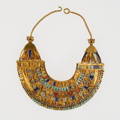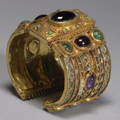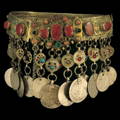Available 7 days - hours will vary (EST): +1 (862) 222-0442
7 days, hours vary (EST): +1 (862) 222-0442

Cloisonné
When we think of enamel jewelry we often hear the term "cloisonné" (which means compartments). These compartments are formed by tiny wires fused to the form of the jewelry being decorated and used to keep the enamel (which is introduced as molten colored glass) from running into undesired spaces.
Although enamel requires cloisonné, cloisonné doesn't require enamel! In fact, some of the earliest examples of cloisonne jewelry (and the inspiration for the use of enamel) came from the Egyptians.
Shown above is the necklace centerpiece of Princess Sithathoryunet. The centerpiece was made from 372 individually cut semiprecious stones such as turquoise, carnelian and lapis.

Shown above is an extraordinary example of Egyptian cloisonné that clearly shows the "compartments" the technique is named for. This example also uses carnelian, lapis and turquoise but the truly incredible part is that (if you are viewing this on a desktop), it's roughly life-size. This necklace was a miniature possibly meant for a funerary figure.
A side note on symbology:
The Princess Sithathoryunet necklace (above) features an enormous amount of symbology: The Falcons symbolize Ra, the zig zags at the bottom are water, and ankhs represent "life". The idea of intricacy and meaning in the design work of Greek jewelry borrowed from this concept.
The purpose of women's jewelry in ancient Egypt was more than adornment or status; it symbolized myths and concepts of Egyptian royalty and granted them superhuman powers to support their country and culture.

Hellenism: Development of the craft:
2100 BC: At the mouth of the Dnieper River in present day Ukraine there was once a Greek colony called Olbia. It's location and trading ties throughout the Mediterranean guaranteed a mix of cultures that can be seen in this remarkable bracelet discovered in the late 19th century.
One of the cultures, the "Scythians", reached across the Russian steppe, through the caucuses and into present day Turkey and Iran. The Scythians were famous for their prowess in horseback warfare, but in terms of jewelry they are revered as some of the fines goldsmiths in history.
From it's trading routes Olbia also gained familiarity with the cloisonné techniques developed in Egypt, the melting of glass from various Mesopotamian cultures and the burgeoning decorative arts of Hellenistic Greece.
In the example above we see enamel filling the compartments along the sides of the bracelet. At the time it was seen as a less expensive decorative element than the large garnets, amethyst, chrysoprase and emeralds also incorporated into the piece, hence the out-of-the-way positioning along the sides.
Our favorite element: The center row of 3 dimensional enamel filled panels echoing palm leaves flanking the amethyst.

The Ottoman occupation:
Working with less
During the Ottoman occupation of Greece precious metals and stones were not to be found in abundance.
This collar necklace is representative of those scarcities. The expensive stones found in Byzantine jewelry (emeralds, rubies, sapphires) were replaced with carnelian, coral and turquoise.
Given the situation, enamel was an obvious choice for adding color to pieces such as this. It can be found on the collar between the large carnelian stones.
This 18th century necklace features another common element of the time; coins! Despite rumors that these were sometimes used for emergency funding, these were meant as a show of wealth and status. These coins were from Austria.
This piece is currently at the Benaki Museum in Athens which is a great place to visit on your trip!
Cloisonné
When we think of enamel jewelry we often hear the term "cloisonné" (which means compartments). These compartments are formed by tiny wires fused to the form of the jewelry being decorated and used to keep the enamel (which is introduced as molten colored glass) from running into undesired spaces.
Although enamel requires cloisonné, cloisonné doesn't require enamel! In fact, some of the earliest examples of cloisonne jewelry (and the inspiration for the use of enamel) came from the Egyptians.
Shown here is the necklace of Princess Sithathoryunet. The centerpiece was made from 372 individually cut semiprecious stones such as turquoise, carnelian and lapis.
Shown to the left is an extraordinary example of Egyptian cloisonné that clearly shows the "compartments" the technique is named for. This example also uses carnelian, lapis and turquoise but the truly incredible part is that (if you are viewing this on a desktop), it's roughly life-size. This necklace was a miniature possibly meant for a funerary figure.
A side note on symbology:
The Princess Sithathoryunet necklace (above) features an enormous amount of symbology: The Falcons symbolize Ra, the zig zags at the bottom are water, and ankhs represent "life". The idea of intricacy and meaning in the design work of Greek jewelry borrowed from this concept.
The purpose of women's jewelry in ancient Egypt was more than adornment or status; it symbolized myths and concepts of Egyptian royalty and granted them superhuman powers to support their country and culture.
Hellenism: Development of the craft
2100 BC: At the mouth of the Dnieper River in present day Ukraine there was once a Greek colony called Olbia. It's location and trading ties throughout the Mediterranean guaranteed a mix of cultures that can be seen in this remarkable bracelet discovered in the late 19th century.
One of the cultures, the "Scythians", reached across the Russian steppe, through the caucuses and into present day Turkey and Iran. The Scythians were famous for their prowess in horseback warfare, but in terms of jewelry they are revered as some of the fines goldsmiths in history.
From it's trading routes Olbia also gained familiarity with the cloisonné techniques developed in Egypt, the melting of glass from various Mesopotamian cultures and the burgeoning decorative arts of Hellenistic Greece.
In this example we see enamel filling the compartments along the sides of the bracelet. At the time it was seen as a less expensive decorative element than the large garnets, amethyst, chrysoprase and emeralds also incorporated into the piece, hence the out-of-the-way positioning along the sides.
Our favorite element: The center row of 3 dimensional enamel filled panels echoing palm leaves flanking the amethyst.
The Ottoman occupation - Working with less
During the Ottoman occupation of Greece precious metals and stones were not to be found in abundance.
This collar necklace is representative of those scarcities. The expensive stones found in Byzantine jewelry (emeralds, rubies, sapphires) were replaced with carnelian, coral and turquoise.
Given the situation, enamel was an obvious choice for adding color to pieces such as this. It can be found on the collar between the large carnelian stones.
This 18th century necklace features another common element of the time; coins! Despite rumors that these were sometimes used for emergency funding, these were meant as a show of wealth and status. These coins were from Austria.
This piece is currently at the Benaki Museum in Athens which is a great place to visit on your trip!
The mobile version of Athena Gaia has been abridged for faster navigation. We invite you to visit on desktop for a deeper cultural experience, more historical content & video presentations.

0 of 3 items selected